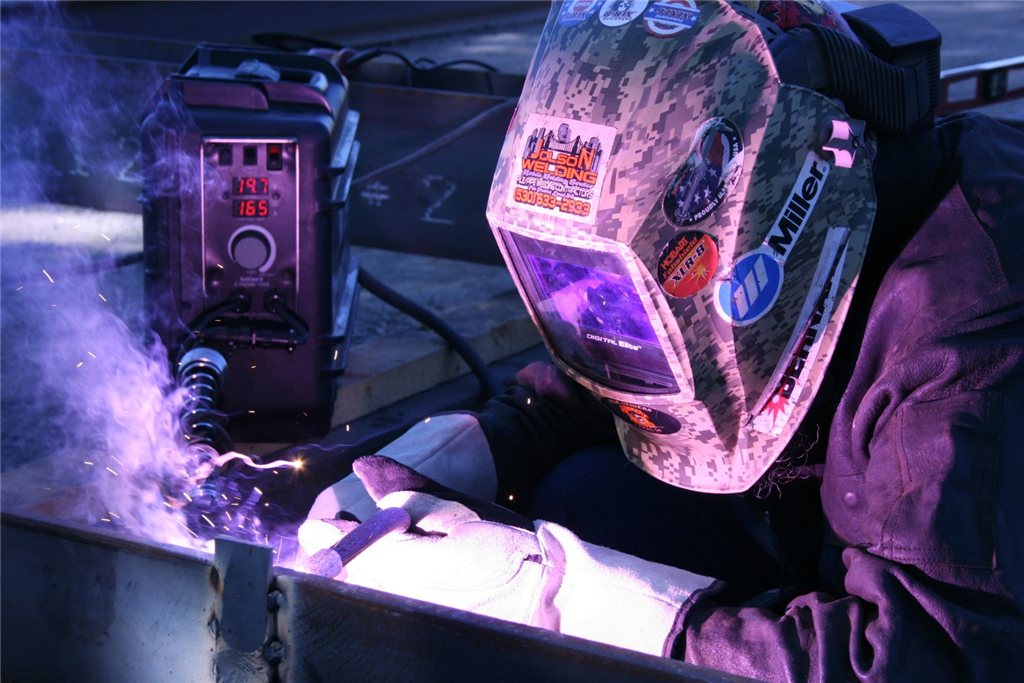
Many structural steel welders are very familiar with the stick welding process and asking them to try out a new process such as self-shielded flux-cored arc welding (FCAW-S) can be a daunting task. In this article, we will explore the differences between both welding processes so you can make a more informed decision.
Basics of FCAW-S
The FCAW-S process consists of a tubular wire that is continuously fed through a welding gun into the weld joint. The flux compound inside the wire reacts with the welding arc to create a shielding gas that protects the weld puddle. As such, FCAW-S does not require any gas cylinders on the jobsite. In addition, FCAW-S can be used in windy conditions and is also more forgiving when welding contaminated base materials.
Welding Performance
With FCAW-S, the opened wire spool needs to be stored in a dry, enclosed environment in its original packaging, and reconditioning is not recommended. On the other hand, stick electrodes need to be stored in an oven to keep them dry. After long periods of exposure to the environment, the electrodes will need to be reconditioned.
The deposition efficiency is the percentage of filler metal that ends up in the weld metal. Deposition efficiency is usually never 100% because there will be loss due to spatter and fumes. With FCAW-S, the deposition efficiency is 85%, while the deposition efficiency for stick is 65% because of the electrode stub loss.
The arc-on time for FCAW-S is also higher compared to stick welding, 45% versus 30%. With stick welding, there is usually more starts and stops because welders need to constantly change out the electrode, reposition themselves and then restart the arc.
Lastly, because FCAW-S is a semi-automatic process, the deposition rate and travel speeds are also substantially higher compared to the manual stick process. The higher deposition rates of the FCAW-S process, at 4 to 12 lbs/hour, allows for higher travel speeds of between 10 to 12 inches-per-minute. With stick welding, you can only deposit 2 to 8 lbs/hour, resulting in a lower travel speed of 5 to 7 inches-per-minute.
Welding Equipment
The stick welding process only requires a constant current welding machine on which the welder will set the amperage, and an electrode holder. The initial investment costs is usually lower compared to the FCAW-S process.
For FCAW-S, you will need a welding machine that can give a constant voltage output. In addition, you will need to purchase more accessories such as a wire feeder, drive rolls, welding gun, gun consumables etc. Since the FCAW-S wire comes in various sizes, it is important to ensure that the correct accessories are purchased to fit the size of the wire you intend to use for your operations.
In addition, it is critical to use the correct type of drive rolls when welding FCAW-S to ensure proper wire feeding. For FCAW-S wires, V-knurled drive rolls are usually recommended since these provide sufficient traction to grip the wire without deforming it.
Welding Techniques and Filler Metal Selection
When welding either stick or FCAW-S, a 10 to 15 degree backhand technique is usually recommended when welding in the down hand position. For FCAW-S, the contact tip to work distance to be used will depend on the diameter and type of wire to be welded. As a general rule of thumb, the larger the diameter of the wire, the longer the contact tip to work distance will be.
If there is an intention to switch from stick to FCAW-S, it is crucial to select a wire that has a similar chemistry and mechanical property as compared to the electrode. For example, in structural steel applications, T-8 FCAW-S wires can offer equivalent tensile and yield strengths to 7018 stick electrodes. Certain T-8 wires also feature a D designator, which means the filler metal can be used in special seismic applications.
Before making the switch, it is also critical to determine the hydrogen level requirements of the job. 7018 stick electrodes can offer very low diffusible hydrogen content, about 4 ml per 100g. On the other hand, most T-8 wires are designed for a diffusible hydrogen content of less than 8 ml per 100g. That being said, some filler metal manufacturers are able to offer H5 tested controlled lots for the FCAW-S wires.
Additional Considerations
While it is clear that converting from stick to FCAW-S can offer many advantages such as higher deposition rates, deposition efficiency and arc-on time, it also comes with a higher initial investment cost. You will need to evaluate if you can recover this cost within your company’s predetermined payback period.
Additionally, you will also need to consider the skillsets of your existing welders. If you employ a very experienced crew of welders who have been stick welding for many years, then you will need to consider if the expense and time required to retrain them to the FCAW-S process is worth it.
Before you make the leap from stick to FCAW-S, make sure you consider all the factors involved. If you need help during your evaluation process, always consult your trusted welding supplier for more insights.